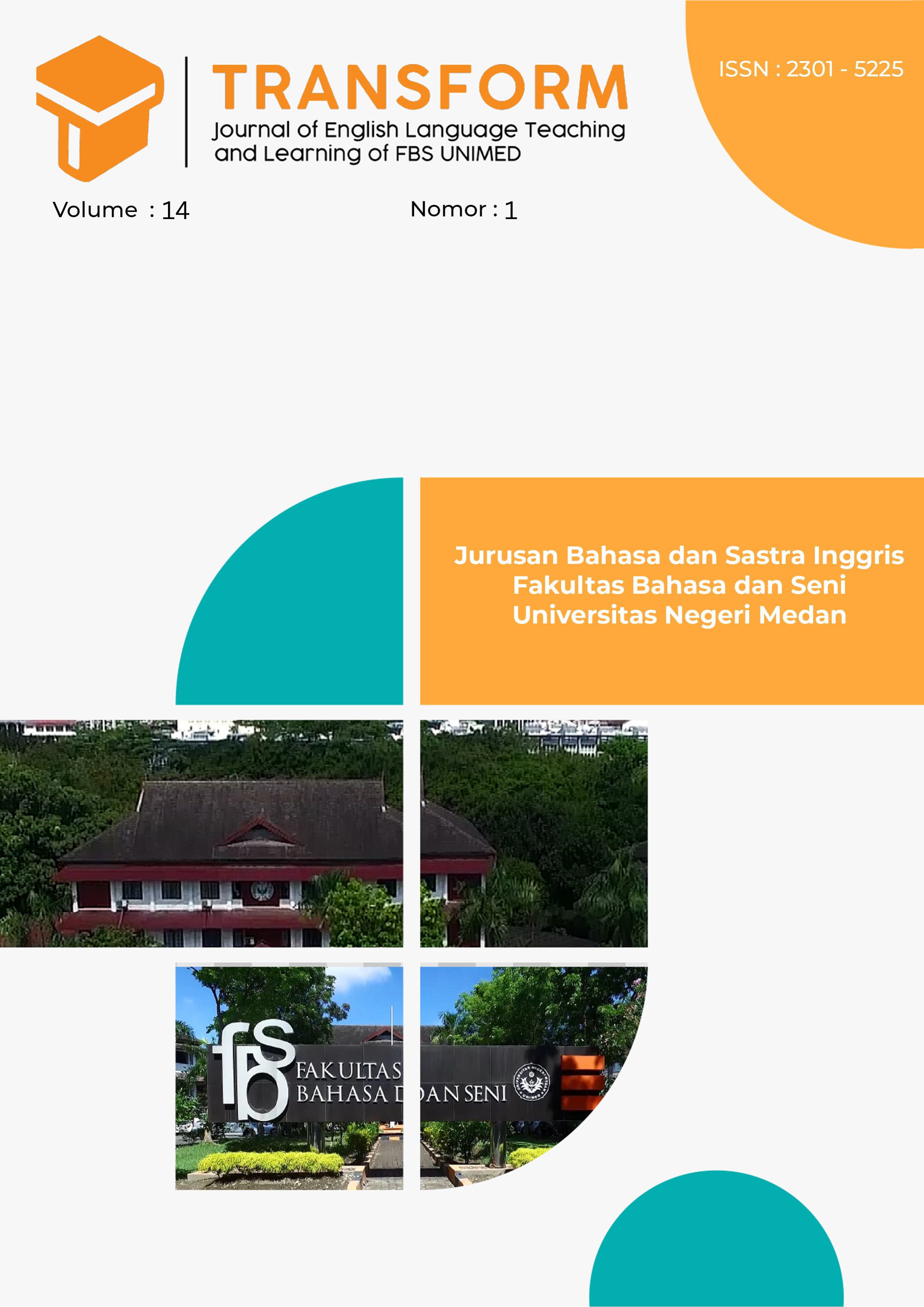The Impact of TikTok Usage on English Language Acquisition Among Adolescent Students in HKBP Siantar Timur
DOI:
https://doi.org/10.24114/tj.v14i1.67334Keywords:
Social Media, TikTok, Adolescent Student, English AcquisitionAbstract
This comprehensive study investigates the multifaceted impact of TikTok usage on English language acquisition among adolescent students in HKBP Siantar Timur. Employing a mixed-methods approach, this research delves deep into how TikTok influences various aspects of language learning, including vocabulary acquisition, listening comprehension, speaking skills, and cultural awareness. The study surveyed 21 teenagers aged 15-17, meticulously analyzing their TikTok usage patterns, language preferences, learning strategies, and perceived impacts on English proficiency. Additionally, in-depth interviews were conducted with a subset of participants to gain richer insights into their experiences and perceptions. Results indicate that while TikTok offers engaging and diverse content for language learning, students face significant challenges such as distraction, content reliability, and the need for critical digital literacy skills. The study reveals complex relationships between TikTok usage frequency, content types, and perceived language improvements. Notably, students who actively engaged with educational content and international users reported higher perceived gains in language skills. This research provides nuanced insights for educators, policymakers, and researchers on leveraging social media platforms for language education in the digital age. It highlights the need for structured guidance, curated content, and the development of digital literacy skills to maximize the potential of platforms like TikTok in formal and informal language learning contexts.References
Arnett, J. J. (2019). Adolescence and emerging adulthood: A cultural perspective. Pearson.
Bjorklund, D. F., & Causey, K. B. (2017). Child and adolescent development: An integrated approach. Sage Publications.
Boyd, D. (2010). Media social definition: A perspective. Journal of Social Media Studies, 5(2), 45-58.
Brick, B. (2012). The role of social networking sites for language learning in UK higher education: The views of learners and practitioners. International Journal of Computer-Assisted Language Learning and Teaching, 2(3), 35-53.
Celce-Murcia, M., & Silva, O. M. (2014). The art of teaching speaking: Research and pedagogy for the ESL/EFL classroom. Cengage Learning.
Chen, Y. (2023). Cultural exchange and language learning through TikTok: A global perspective. Journal of Intercultural Communication, 26(2), 178-195.
Crystal, D. (2003). English as a global language: Implications and influence. International Communication Journal, 10(2), 87-101.
Escamilla-Fajardo, P., Alguacil, M., & López-Carril, S. (2021). Incorporating TikTok in higher education: Pedagogical perspectives from a corporal expression sport sciences course. Journal of Hospitality, Leisure, Sport & Tourism Education, 28, 100302.
Gass, S. M., & Selinker, L. (2008). Second language acquisition: An introductory course. Routledge.
Godwin-Jones, R. (2018). Using mobile devices in the language classroom: Part of the Cambridge papers in ELT series. Cambridge University Press.
Goldin-Meadow, S. (2020). Theories of language acquisition. In Encyclopedia of infant and early childhood development (pp. 356-364). Elsevier.
Jin, L. (2018). Digital affordances on WeChat: Learning Chinese as a second language. Computer Assisted Language Learning, 31(1-2), 27-52.
Kukulska-Hulme, A., Lee, H., & Norris, L. (2021). Mobile assistance for personal learning on a massive scale. In H. Crompton & J. Traxler (Eds.), Critical mobile pedagogy (pp. 195-212). Routledge.
Lai, C., & Zheng, D. (2018). Self-directed use of mobile devices for language learning beyond the classroom. ReCALL, 30(3), 299-318.
Literat, I. (2021). “Teachers act like we're robots”: TikTok as a window into youth experiences of online learning during COVID-19. AERA Open, 7, 2332858421995537.
Martin, J. (2022). The power of digital media. Cambridge University Press.
Mondahl, M., & Razmerita, L. (2014). Social media, collaboration and social learning–A case- study of foreign language learning. Electronic Journal of E-Learning, 12(4), 339-352.
Palmgren, A.-C., Andersson, E., & Bista, S. (2023). Learning on social media: A study of young people's use of TikTok. Journal of Youth Studies, 1-18.
Pegrum, M. (2014). Mobile learning: Languages, literacies and cultures. Springer.
Pinker, S. (1994). The language instinct: Understanding how language shapes thought. Harper Perennial.
Pontianak, Universitas Tanjungpura. (2020). Factors, phonology, morphology, syntax, and semantics of second language acquisition in students' kindergarten (TK) Pontianak. International Journal of Applied Linguistics and English Literature, 17398-17404.
Prihodko, A., & Mamonova, O. (2024). Digital literacy and language acquisition through social media: The case of English learners on TikTok. Computer Assisted Language Learning, 37(1), 45-63.
Reinhardt, J. (2020). Metaphors for social media-enhanced foreign language teaching and learning. Foreign Language Annals, 53(2), 234-242.
Seli, H. (2020). Children's language acquisition: A fresh look at the debate. Routledge.
Skinner, B. F. (1957). Verbal behavior. Appleton-Century-Crofts.
Solomon, M. (2018). Social media: Enduring principles. SAGE Publications.
Tour, E. (2015). Digital mindsets: Teachers' technology use in personal life and teaching.
Language Learning & Technology, 19(3), 124-139.
Warschauer, M., & Ishikawa, Y. (Eds.). (2019). Digital media and English language learners: Research-based technology integration. Routledge.
Woolfolk, A. (2019). Educational psychology: Active learning edition. Pearson.
Zourou, K. (2012). On the attractiveness of social media for language learning: A look at the state of the art. ALSIC. Apprentissage des Langues et Systèmes d'Information et de Communication, 15(1).
Downloads
Published
How to Cite
Issue
Section
License
Copyright (c) 2025 Marino Sihombing, Bernieke Damanik

This work is licensed under a Creative Commons Attribution-ShareAlike 4.0 International License.
Authors who publish with this journal agree with the following terms:
- Authors retain copyright and grant the journal right of first publication with the work simultaneously licensed under a Creative Commons Attribution License that allows others to share the work with an acknowledgment of the work's authorship and initial publication in this journal.
- Authors are able to enter into separate, additional contractual arrangements for the non-exclusive distribution of the journal's published version of the work (e.g., post it to an institutional repository or publish it in a book), with an acknowledgment of its initial publication in this journal.
- Authors are permitted and encouraged to post their work online (e.g., in institutional repositories or on their website) prior to and during the submission process, as it can lead to productive exchanges, as well as earlier and greater citation of published work (See The Effect of Open Access).
- This work is licensed under a Creative Commons Attribution-ShareAlike 4.0 International License.








